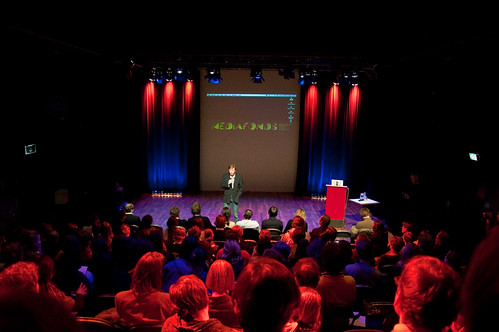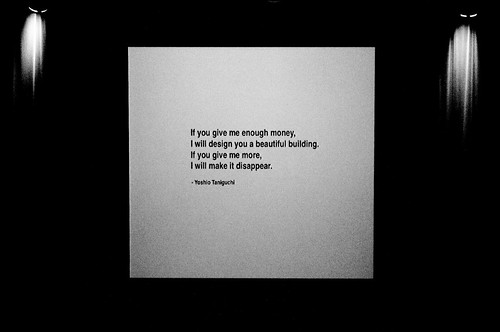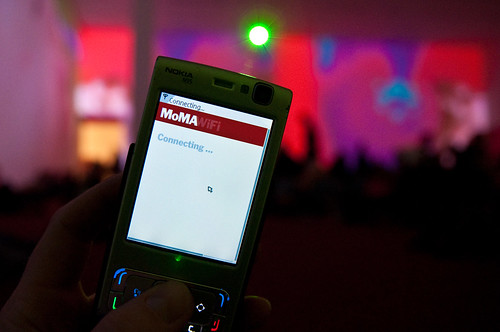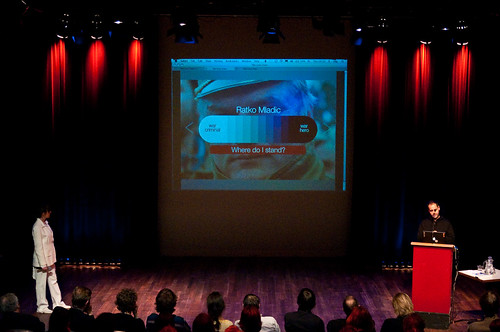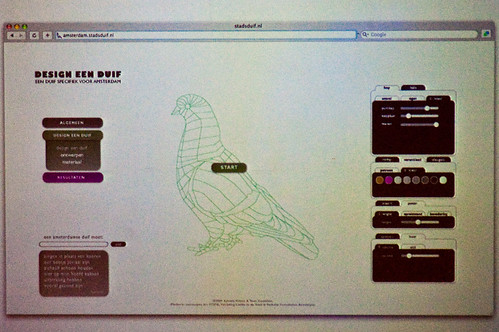Introduction by Martijn de Waal
The Stifo@Sandberg workshop used to have a revolutionary edge to it which has now gone because the media have established their legitimacy. As media have matured, the workshop no longer focuses on the revolutionary media type but on the media specific grammar. The workshop now zooms in on a specific medium and tries to understand, expose and use it’s language. How can we use a particular medium to achieve a certain goal?
Lotte Meijer & Erin Moore – Tuesday
 Tuesday is an interactive tour made for the Museum of Modern Art New York (MoMA). Lotte describes how the museum oozes a form of complete perfection which transforms the museum into a non-place. Yoshio Taniguchi, the MoMA architect responsible for the redesign of the museum said the following when presenting his redesign:
Tuesday is an interactive tour made for the Museum of Modern Art New York (MoMA). Lotte describes how the museum oozes a form of complete perfection which transforms the museum into a non-place. Yoshio Taniguchi, the MoMA architect responsible for the redesign of the museum said the following when presenting his redesign:
This disappearing of the museum transformed it into a non-personal sterile place and Meijer and Moore wanted to bring back the stories and turn it into a personal space. Lotte Meijer collected stories about the museum from it’s employees, ranging from educational guides, to cleaners and nightwatchers during her one year internship.
Visitors can connect to the MoMA wireless network with their iPhone and discover unknown stories about the museum: Jim is a painter at the museum and paints the same spots every single week: parts of the walls the guards lean into during their shifts. A nightwatch who moves one of the museum benches through the emergency exit into the staircase where it’s dark so he can get some sleep. These stories show a more “human” side of the museum to its visitors.
The application is called Tuesday because the museum is closed on Tuesdays and Meijer collected most of her stories on Tuesday.
Lidija Zelovic & Rog̩rio Lira РThe Grey Zone
The world is a polarized place. We like to think we live in an open-minded society where our media is free but we still only get a partial perception of stories. We use debates and discussions to expand our view of the world but we sometimes conform or adjust ourselves to the ones around us. The concept of the Grey Zone is that we need a new platform that make us aware of preconceived ideas. The Grey Zone collects videos on a certain topic and wants to test how open minded we are.
After watching a video which expresses an opinion the question is asked where you stand on a certain topic. The view points are than mapped onto a white/gray/black area. The platform wishes to introduce people to the grey zone.
Lidija Zelovic & Rogério Lira wanted to make the tool as intimate as possible. Current social networking tools focus on creating your own image where people sometimes put a lot of time and effort in constructing their online presence. In the Grey Zone, however, it is completely anonymous and no one is judging your reaction. There are no comments possible so there is very little information noise in the videos. Every argument is an idea that stands for itself, you don’t value the maker but you value the idea. You can upload your own video reaction/standpoint and you can edit existing videos to combine different arguments that are there already. The question is: How much control can users have in creating their own topics? In order to avoid abuse there is a so called alarm button for provocative videos.
The concept in itself sounds quite idealistic in the sense that they focus on the user group of artists and media students. This seems a public that is very much dedicated to opening up a debate and provide a grey area that also needs to be discussed, however (mis)use of the system from outside of the focus group seems likely.
Teun Castelein & Sylvain Vriens – Stadsduif
The pigeon is a symbol for peace and love but in Amsterdam it stands for grey-winged rats. Amsterdam needs a new pigeon. In the era of ‘city-branding’ (I amsterdam) why not use pigeons? On the website stadsduif.nl (city-pigeon) you can design your own pigeon. Eindhoven, the light city, could use a pigeon that glows in the dark.
The carrier pigeon has lost its function but a glow in the dark pigeon would regain an actual function. It would also give the pigeons a new and positive image after ruining your balcony for years.
The stadsduif project gives us a critical look into the world of citybranding and manipulating species by “designing” them.
Ghalia Elsrakbi & Florian Conradi – State 2.0
Elsrakbi and Conradi provide us with a state for the stateless. The virtual world seems to be an endless territory so why can’t we claim a state for the stateless people? The application imports data from Facebook and Flickr in order to embody your new state.

It reminded me of the place of Palestina on the web by Richard Rogers and Anat David-Ben at Govcom.org which deals with the acknowledgement of the non-existent state of Palestina on the web. Have a look at these visuals of Mapping the Palestinian Web Space (2008).
More pictures of the event can be found on Flickr.
